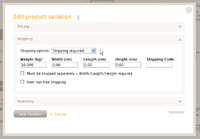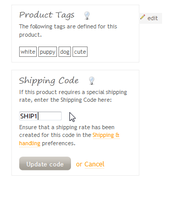How does Shipping work?
From Spiffy Stores Knowledge Base
When a customer purchases items from your store, you're generally going to need to ship these items to the customer, so you will need some way of calculating the cost of shipping so that you can add that cost to the order.
Of course, not all items need shipping and you can configure which product variations need to be shipped by clicking on the variation on the product page and bringing up the edit dialog. Just click on the "Shipping" bar to show all the shipping options, and then select "No shipping required" from the selection box.
When you're finished, click on "Save Variation".
Of course, normally you will want to ship your products, so make sure you understand all of the shipping options that can be configured for a product variation.
Contents
Shipping Rate Types
Weight-based Shipping Rates
The most common form of shipping rate is based upon the total weight of the items in the shopping cart.
In order to use a weight-based shipping rate, you will need to define one or more shipping rates, and specify the range of weights that to which the rate applies.
For example, if you define a weight-based shipping rate for the weight range of 0 kgs to 20 kgs, then this rate will apply if the total weight of all items in the shopping cart is greater than 0 kgs and less than or equal to 20 kgs.
Note: All weight-based shipping rate ranges are matched if the total weight of the items in the shopping cart is greater than the low value and less than or equal to the high value.
This means that you can define multiple shipping rates, each covering a specific range without any overlap or gaps in the range. For example,
0kg - 5kg Range 1 5kg - 10kg Range 2 10kg - 20kg Range 3
As weight-based shipping rates are based upon weight, it is important that you provide an accurate weight for each of your product variations. Please also allow for any extra weight that is added in the form of packaging.
If a customer orders multiple quantities of the same product variation, then the total weight for that item equals the weight you specified for the variation times the number of items ordered.
A weight-based shipping rate can have either a fixed price or the shipping cost can be calculated automatically by using one of the provided Shipping Agents.
Spiffy Stores supports a number of Shipping Agents, such as Australia Post, New Zealand Post, Fastway Couriers and FedEx. In coming months, we will be expanding our list of supported agents.
Instructions on how to use a shipping agent to automatically calculate shipping costs for your customers in your stores' checkout can be found by following the links below.
- Using Australia Post Shipping
- Using New Zealand Post Shipping
- Using Fastway Couriers Shipping
- Using FedEx Shipping
Price-based Shipping Rates
Price-based shipping rates allow you to specify the cost of shipping based upon the total value of the shopping cart. You can use this to provide a simple set of flat rate shipping costs that are depend upon how much the customer spends.
You can provide both weight-based and price-based shipping rates. A price-based shipping rate can be used to to provide a single, flat rate shipping cost for customers who spend more than a certain amount. For smaller purchases, the standard weight-based shipping rates can apply.
You can also specify a price-based shipping rate of $0.00, so that you can offer free shipping to customers who spend more than a certain amount.
When a price-based shipping rate is found for an order, it takes precedence over any other weight-based shipping rates that may apply.
Note: All price-based shipping rate ranges are matched if the total price of the items in the shopping cart is greater than or equal to the low value and less than the high value.
Shipping Code-based Shipping Rates
The final type of shipping rate is the Shipping Code-based rate.
This type of shipping rate allows you to define a flat-rate shipping cost and to assign that rate to a shipping code. The shipping code is a 10 character sequence of alphanumeric characters that uniquely identifies that shipping rate.
In order to use this type of shipping rate, you will need to specify the shipping code in the shipping options for each variation or in the product that will use this shipping rate.
You can define a shipping code in two ways.
- A product can have a shipping code. This means that all variations have the same shipping code. When you add a new variation, it automatically inherits the product shipping code.
- Each variation can have a shipping code. If you define a shipping code for a variation, it will be used instead of the product variation code. If you define a product shipping code, you don't need to configure each variation to use the same shipping code. This happens automatically.
You can use this type of rate to provide custom shipping rates for special products that don't fall into the standard weight-based or price-based shipping rate categories.
For example, gift vouchers or products which need special handling can use a shipping code-based shipping rate rather than the standard rates that apply to all other products in the store.
Note: If a product variation is defined using a shipping code-based rate, then that shipping rate must exist, otherwise the customer will be unable to purchase the item. If you define a shipping code, make sure you have created a shipping rate using this code for every country that you are shipping to.
Creating Shipping Code Shipping Rates
For every country, make sure you create a shipping code rate by clicking on the shipping-code rate link to add new shipping rates.
For each new shipping-code rate, use the same shipping code that you have defined in your products and/or variations. The code must match in order for it to be used when calculating the shipping rate for that product variation.
Note: In order to use Shipping Code-based shipping rates, you will need to enable Advanced Shipping Options under "Your Settings" in the Advanced Configuration section.





